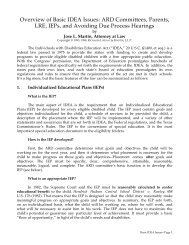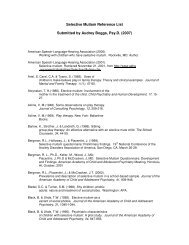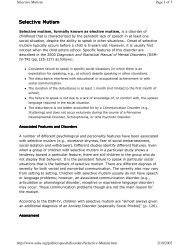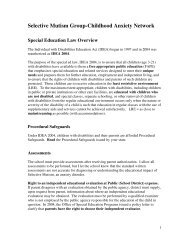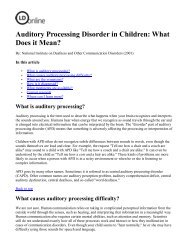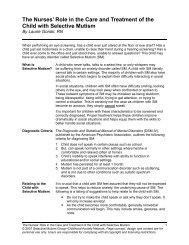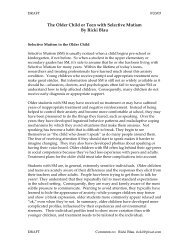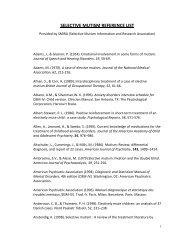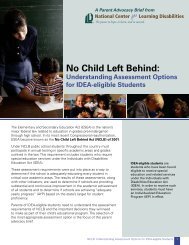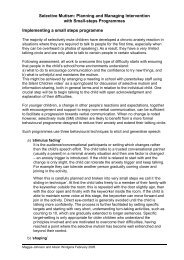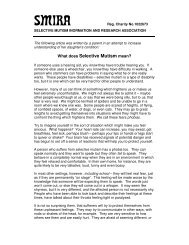Accomodations for Dysgraphia - Selective Mutism Group
Accomodations for Dysgraphia - Selective Mutism Group
Accomodations for Dysgraphia - Selective Mutism Group
- No tags were found...
Create successful ePaper yourself
Turn your PDF publications into a flip-book with our unique Google optimized e-Paper software.
Accommodations and Modifications <strong>for</strong> Students withHandwriting Problems and/or <strong>Dysgraphia</strong>Susan Jones, M.Ed.12/98Many students struggle to produce neat, expressive written work, whether or not theyhave accompanying physical or cognitive difficulties. They may learn much less from anassignment because they must focus on writing mechanics instead of content. Afterspending more time on an assignment than their peers, these students understand thematerial less. Not surprisingly, belief in their ability to learn suffers. When the writingtask is the primary barrier to learning or demonstrating knowledge, thenaccommodations, modifications, and remediation <strong>for</strong> these problems may be in order.There are sound academic reasons <strong>for</strong> students to write extensively. Writing is a complextask that takes years of practice to develop. Effective writing helps people remember,organize, and process in<strong>for</strong>mation. However, <strong>for</strong> some students writing is a laboriousexercise in frustration that does none of those things. Two students can labor over thesame assignment. One may labor with organizing the concepts and expressing them,learning a lot from the 'ordeal.' The other will <strong>for</strong>ce words together, perhaps with greateref<strong>for</strong>t (perhaps less if the language and in<strong>for</strong>mation has not been processed), with none ofthe benefits either to developing writing skills or organizing and expressing knowledge.How can a teacher determine when and what accommodations are merited? The teachershould meet with the student and/or parent(s), to express concern about the student'swriting and listen to the student's perspective. It is important to stress that the issue is notthat the student can't learn the material or do the work, but that the writing problems maybe interfering with learning instead of helping. Discuss how the student can make up <strong>for</strong>what writing doesn't seem to be providing -- are there other ways he can be sure to belearning? Are there ways to learn to write better? How can writing assignments bechanged to help him learn the most from those assignments? From this discussion,everyone involved can build a plan of modifications, accommodations, and remediationsthat will engage the student in reaching his best potential.SIGNS OF DYSGRAPHIA:Generally illegible writing (despite appropriate time and attention given the task)Inconsistencies : mixtures of print and cursive, upper and lower case, or irregularsizes, shapes, or slant of lettersUnfinished words or letters, omitted wordsInconsistent position on page with respect to lines and marginsInconsistent spaces between words and letters
Cramped or unusual grip, especiallyholding the writing instrument very close to the paper, orholding thumb over two fingers and writing from the wristStrange wrist, body, or paper positionTalking to self while writing, or carefully watching the hand that is writingSlow or labored copying or writing - even if it is neat and legibleContent which does not reflect the student's other language skillsWHAT TO DO ABOUT DYSGRAPHIA:Accommodate -- reduce the impact that writing has on learning or expressingknowledge -- without substantially changing the process or the product.Modify -- change the assignments or expectations to meet the student's individualneeds <strong>for</strong> learningRemediate - provide instruction and opportunity <strong>for</strong> improving handwritingACCOMMODATIONS FOR DYSGRAPHIA:When considering accommodating or modifying expectations to deal with dysgraphia,consider changes in1. the rate of producing written work,2. the volume of the work to be produced,3. the complexity of the writing task, and4. the tools used to produce the written product, and5. the <strong>for</strong>mat of the product.1. Change the demands of writing rate:Allow more time <strong>for</strong> written tasks including note-taking, copying, and testsAllow students to begin projects or assignments earlyInclude time in the student's schedule <strong>for</strong> being a 'library assistant' or 'office assistant'that could also be used <strong>for</strong> catching up or getting ahead on written work, or doingalternative activities related to the material being learned.Encourage learning keyboarding skills to increase the speed and legibility of writtenwork.
Have the student prepare assignment papers in advance with required headings (Name,Date, etc.), possibly using the template described below under "changes incomplexity."2. Adjust the volume:Instead of having the student write a complete set of notes, provide a partiallycompleted outline so the student can fill in the details under major headings (orprovide the details and have the student provide the headings).Allow the student to dictate some assignments or tests (or parts of tests) a 'scribe'.Train the 'scribe' to write what the student says verbatim ("I'm going to be yoursecretary") and then allow the student to make changes, without assistance from thescribe.Remove 'neatness' or 'spelling' (or both) as grading criteria <strong>for</strong> some assignments, ordesign assignments to be evaluated on specific parts of the writing process.Allow abbreviations in some writing (such as b/c <strong>for</strong> because). Have the studentdevelop a repertoire of abbreviations in a notebook. These will come in handy in futurenote-taking situations.Reduce copying aspects of work; <strong>for</strong> example, in Math, provide a worksheet with theproblems already on it instead of having the student copy the problems.3. Change the Complexity:Have a 'writing binder' option. This 3-ring binder could include:a model of cursive or print letters on the inside cover (this is easier to refer to thanone on the wall or blackboard). IA laminated template of the required <strong>for</strong>mat <strong>for</strong> written work. Make a cut-out wherethe name, date, and assignment would go and model it next to the cutout. Three-holepunch it and put it into the binder on top of the student's writing paper. Then thestudent can set up his paper and copy the heading in<strong>for</strong>mation in the holes, then flipthe template out of the way to finish the assignment. He can do this withworksheets, too.Break writing into stages and teach students to do the same. Teach the stages of thewriting process (brainstorming, drafting, editing, and proofreading, etc.). Considergrading these stages even on some 'one-sitting' written exercises, so that points areawarded on a short essay <strong>for</strong> brainstorming and a rough draft, as well as the finalproduct. If writing is laborious, allow the student to make some editing marks ratherthan recopying the whole thing.On a computer, a student can make a rough draft, copy it, and then revise the copy, sothat both the rough draft and final product can be evaluated without extra typing.Do not count spelling on rough drafts or one-sitting assignments.
Encourage the student to use a spellchecker and to have someone else proofread hiswork, too. Speaking spellcheckers are recommended, especially if the student may notbe able to recognize the correct word (headphones are usually included).4. Change the tools:Allow the student to use cursive or manuscript, whichever is most legibleConsider teaching cursive earlier than would be expected, as some students findcursive easier to manage, and this will allow the student more time to learn it.Encourage primary students to use paper with the raised lines to keep writing on theline.Allow older students to use the line width of their choice. Keep in mind that somestudents use small writing to disguise its messiness or spelling, though.Allow students to use paper or writing instruments of different colors.Allow student to use graph paper <strong>for</strong> math, or to turn lined paper sideways, to helpwith lining up columns of numbers.Allow the student to use the writing instrument that is most com<strong>for</strong>table. Manystudents have difficulty writing with ballpoint pens, preferring pencils or pens whichhave more friction in contact with the paper. Mechanical pencils are very popular. Letthe student find a 'favorite pen' or pencil (and then get more than one like that).Have some fun grips available <strong>for</strong> everybody, no matter what the grade. Sometimeshigh school kids will enjoy the novelty of pencil grips or even big "primary pencils."Word Processing should be an option <strong>for</strong> many reasons. Bear in mind that <strong>for</strong> many ofthese students, learning to use a word processor will be difficult <strong>for</strong> the same reasonsthat handwriting is difficult. There are some keyboarding instructional programs whichaddress the needs of learning disabled students. Features may include teaching thekeys alphabetically (instead of the "home row" sequence), or sensors to change the'feel' of the D and K keys so that the student can find the right position kinesthetically.Consider whether use of speech recognition software will be helpful. As with wordprocessing, the same issues which make writing difficult can make learning to usespeech recognition software difficult, especially if the student has reading or speechchallenges. However, if the student and teacher are willing to invest time and ef<strong>for</strong>t in'training' the software to the student's voice and learning to use it, the student can befreed from the motor processes of writing or keyboarding.MODIFICATIONS FOR DYSGRAPHIA:For some students and situations, accommodations will be inadequate to remove thebarriers that their writing problems pose. Here are some ways assignments can bemodified without sacrificing learning.1. Adjust the volume:
Keep in mind that handwriting habits are entrenched early. Be<strong>for</strong>e engaging in a battleover a student's grip or whether they should be writing in cursive or print, considerwhether en<strong>for</strong>cing a change in habits will eventually make the writing task a lot easier<strong>for</strong> the student, or whether this is a chance <strong>for</strong> the student to make his or her ownchoices.Teach alternative handwriting methods such as "Handwriting Without Tears."Even if the student employs accommodations <strong>for</strong> writing, and uses a word processor<strong>for</strong> most work, it is still important to develop and maintain legible writing. Considerbalancing accommodations and modifications in content area work with continuedwork on handwriting or other written language skills. For example, a student <strong>for</strong> whomyou are not going to grade spelling or neatness on certain assignments may be requiredto add a page of spelling or handwriting practice to his portfolio.More in<strong>for</strong>mation on <strong>Dysgraphia</strong>:Richards, Regina G. The Writing Dilemma: Understanding <strong>Dysgraphia</strong>. RET CenterPress. 1998. This booklet defines and outlines the stages of writing, the effects ofdifferent pencil grips on writing, and dysgraphia symptoms. Guidelines are provided toidentify students with dysgraphia and specific helps and compensations areprovided.Regina G. Richards. Find it at amazon.comLevine, Melvin. Educational Care: A System <strong>for</strong> Understanding and Helping Childrenwith Learning Problems at Home and in School. Cambridge, MA: Educator's PublishingService. 1994. Concise, well organized descriptions of specific learning tasks, variationsin the ways students process in<strong>for</strong>mation, and concrete techniques that teachers andparents can use to bypass areas of difficulty. Find it at amazon.comOlsen, Jan Z. Handwriting Without Tears. Find it at amazon.comShannon, Molly, OTR/L <strong>Dysgraphia</strong> Defined: The Who, What, When, Where and Whyof <strong>Dysgraphia</strong> - conference presentation, 10/10/98. web4246@charweb.orgRelated articles:When Writing's a Problem: A description of dysgraphia - by Regina Richards, a greatstarting place.LD OnLine In Depth: Writing (Many articles about writing and learning disabilities)Overview of Assistive Technology - 1998 - Marshall Raskind, Ph.D. and EleanorHiggins, Ph.D. His article, while focusing primarily on secondary and adult assistivetechnology <strong>for</strong> people with learning disabilities, provides specific descriptions of
different types of assistive technology, such as writing assistance software. It alsodescribes the process of determining how to choose and use assistive technology devices.Keyboarding programs <strong>for</strong> students with special needs - part of LD OnLine's listingof Assistive Technology Resources <strong>for</strong> Students with Learning Disabilities.Making Technology Work in the Inclusive Classroom: A Spell CHECKing Strategy<strong>for</strong> Students with Learning Disabilities - 1998 - Dr. Tamarah Ashton, Ph.D. Thisstrategy helps the student with learning disabilities get the most out of spell checkingsoftware.From Illegible to Understandable: How Word Prediction and Speech Synthesis CanHelp - 1998 - Charles A. MacArthur, Ph.D. New software helps writers by predictingthe word the student wants to type and reading what s/he has written. How, and howmuch, does this help with student writing and spelling?Speech Recognition Software - Daniel J. Rozmiarek, University of Delaware,February 1998 - A review of the new continuous speech recognition software nowavailable.A Manual For Implementing Dragon Dictate - 1998 - John Lubert and ScottCampbell. A step-by-step manual <strong>for</strong> helping students with learning disabilities "train"Dragon Dictate to recognize their speech.© Copyright 1998-1999, Susan Jones, Resource Room.Reprinted at this site with the gracious permission of the author. Thanks Sue.



